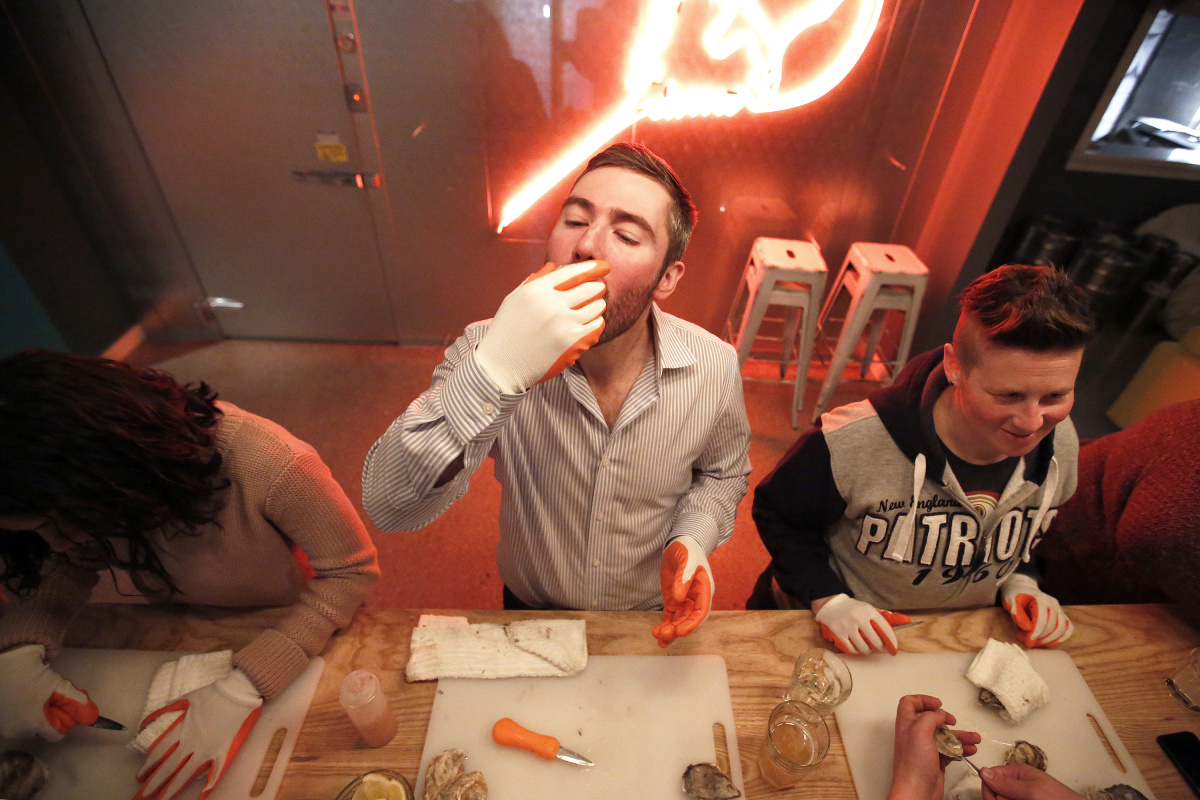As I dug my shucking knife into the hinge of an Island Creek oyster, I recalled what Kit Paschal, manager of The Shop, had said a few minutes earlier – that shucking an oyster is “90 percent finesse and 10 percent force.” As I leaned into it and the little bivalve still refused to budge, it was feeling like the other way around.
It was a cold Thursday night, and I was taking a shucking class at The Shop, a new oyster bar and store on Washington Avenue in Portland. I grew up eating the occasional raw oyster, and as an adult I lived on the Chesapeake Bay for three years at a time when its oyster population was still relatively healthy. But I can’t remember the last time I actually opened one. When it comes to enjoying a raw oyster, I’ve been as privileged as the cigar-smoking walrus in Walt Disney’s “Alice in Wonderland.” While I’ve never coaxed oysters from their shells as the harrumphing walrus did in the 1951 animated film, I’ve mostly let other people do the hard work of shucking. On the Chesapeake Bay, I’d go out on the water with oystermen, and they’d shuck a few on the spot. Or I’d have a bowl of oyster stew at my favorite pub. As Maine’s oyster industry has grown, I’ve relied on shuckers in Portland’s finer restaurants to do the dirty work.
So when I heard about the winter oyster-shucking classes at The Shop, I thought it was high time I learned to properly shuck them myself. Apparently a lot of others felt the same way, because the classes sold out quickly, prompting Paschal to add two more to meet the demand.
“Oysters are a huge mystery to people,” Paschal said. “I think that a lot of it revolves around people not being able to open them.”
The hourlong classes are intimate, with no more than five people each, allowing for a lot of one-on-one instruction. Someone canceled at the last minute in our class, so we had only four wannabe shuckers. Even better, our instructor was Chris Sherman, the president of Island Creek Oysters, the Duxbury, Massachusetts, company that built The Shop, who has shucked thousands of oysters in his lifetime. He happened to be in town for an event and offered to teach that night’s class.
Sherman is the Tony Robbins of oyster shucking. Inspirational phrases rolled off his tongue as if he were trying to get us to quit smoking or train for a marathon. “Persistence pays.” “This is the first day of the rest of your life.”
The evening began with a short lecture on the eastern oyster and the geographic and environmental factors that influence how it tastes. Sherman also plugged the company’s nonprofit foundation, which does development work in Haiti and Africa, using aquaculture as a means to help former fishing communities.

Erik Joncas, center, slurps an oyster during shucking class. Students also got protective gloves, a guide and an oyster knife. Staff photos by Ben McCanna
APPROACH THE OYSTER
Then we got down to business. Sherman compared oyster shucking to other important life skills, “like lighting a fire or driving a stick shift. Sticking a pocket knife and jump starting a car in the ignition. This is something that you want to be able to bust out at some moment, somewhere, whether it’s shucking over the sink for a bunch of friends, or when you’re in some sort of survival situation and you stumble across a reef of oysters and you’re, like, ‘I’ve got this!’ ”
He apparently has a much more exciting life than I do.
Each shucking student paid $30 and received an insulated bag for transporting future oyster purchases; a frequent-buyer punch card with the offer “Buy 6 dozen oysters, get the 7th free” (you get your first punch at the class); a pair of orange-and-white oyster gloves; an oyster knife with an orange plastic handle made from recycled ocean waste; a written guide to shucking oysters, featuring an “Oyster Dude” who looks like Jesus; and a half-dozen oysters – three Island Creek oysters from Massachusetts and three Mookie Blues from the Damariscotta River in Maine.
Sherman showed how to grip the knife, putting his thumb about two-thirds up the blade in a kind of choke hold to help maintain dexterity. The most common way shuckers cut themselves, he explained, is when the knife skips out of the oyster’s hinge, a movement that can also scrape or cut your knuckles on the rough shell if you aren’t wearing gloves.
“Now we’re going to approach the oyster,” Sherman said. “Every oyster is the same. Well, that’s not true. This oyster is named Eddie. If you listen closely, you can hear them scream.”
A little oyster humor. Very little.
ALL IN
Sherman demonstrated opening one, being careful to insert the knife into the oyster’s hinge at a 45-degree angle. Then he did a move he calls the “twist and wiggle” to find the gap in the hinge so he could push the knife blade farther in.
“It takes a fair amount of force,” he said. “You don’t want to be too delicate with it, but if you find yourself really having to lean on it, you’re probably not in the right spot. Once you’re in, you can feel it. You’re in.”
As he spoke, we all grabbed an oyster and dug in. I pressed and pressed at first, struggling with getting the knife into the gap in the hinge. It wasn’t long before I was twisting and wiggling, as Sherman instructed. Suddenly, the knife shot into the shell as if it were cutting through butter. I was in!
“Oh, there it goes!” I exclaimed in surprise – that is, surprise that I didn’t slice a finger off.
“There you go,” Sherman said. “Well done. I told you this was the first day of the rest of your life.”
Next, I separated the two shells as he instructed, by inserting the knife about a third of the way – so it won’t damage the oyster meat – and then turning the blade perpendicular.
“This is the part where a lot of people mess it up,” Sherman said. “Scrambled eggs are cool. Scrambled oysters are not.”
After separating the shells, I followed his instructions for cutting the adductor muscle that holds the oyster to the shell. It’s like peeling a potato. “Ideally, what you’re going for is you don’t want any meat dangling off the top shell,” Sherman said.
A little scrape of the knife against the shell, and voila – I had an oyster I could slurp down naked, or with a little lemon juice or Champagne mignonette.
I was feeling good about myself. And feeling bad for Lisa Goldberg, the woman next to me. Goldberg, a Portland resident, was having some trouble. “I got nothin’, ” she told Sherman, still trying to get her knife into her oyster’s hinge. Sherman opened Goldberg’s first oyster for her to demonstrate close-up how it’s done.

Chris Sherman, center, discusses the finer points of oysters during a shucking class at The Shop. Sherman is co-owner of Island Creek Oysters in Duxbury, Mass. Staff photo by Ben McCanna
ONE HUNDRED OYSTERS
“When in doubt, switch oysters,” he suggested, only half joking. Switching to an oyster than opens more readily can build your confidence, and then when you return to the one that gave you trouble, sometimes it just magically opens.
There was more trouble with my second Island Creek oyster – they have pretty thick shells – so I switched to a smaller Mookie Blue and it opened fairly easily. Now I was starting to feel confident. I switched back to an Island Creek. “There it goes,” I cried as my knife slid in after a little struggle. “Woo hoo!”
Meanwhile, Goldberg was still giving it the old college try – and though she was frustrated, she still appeared to be having fun. “It’s way more difficult than I ever expected,” she said. “I’m going to be breaking a sweat.”
Sherman suggested sitting and shucking a 100-count bag of raw oysters some lazy Saturday afternoon. “You will never be the same,” he said. “You’ll never have trouble opening another oyster again.” You’d also better have a lot of oyster-eating friends.
Paschal had given me the same advice. The class gives plenty of pointers, he said, “but nothing will get you there quicker than just doing it.”
“When I took this job, I thought I could shuck oysters, but since then, I’ve opened thousands of oysters and I am much better than I was to start,” Paschal said. “It’s like muscle memory and body mechanics. You have to take notice of what works and what doesn’t work, and then you link all the things that work together and the next thing you know you’re a proficient shucker.”
Hmm, proficient shucker. I wonder how that would look on my resume?

Comments are no longer available on this story